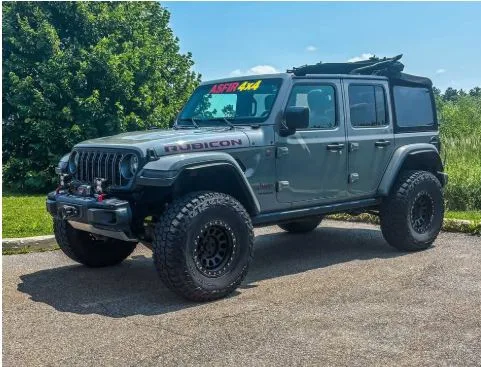Driving Without an Engine Skid Plate: The Hidden Risks Every Driver Should Know
You’d be surprised how many people are driving without an engine skid plate right now without even knowing it. I bet half the cars on your street don’t have proper protection underneath.
Here’s what you have learned after years of seeing preventable engine damage. When you are driving without an engine skid plate, you can save thousands of dollars and a lot of headaches.
In this article, we will guide you through the actual risks, real-world consequences, and practical solutions for keeping your engine protected.
What Happens When You’re Driving Without an Engine Skid Plate
Think about where your engine sits in your car. It’s hanging down there pretty low. Without a skid plate covering it, your oil pan, transmission case, and all those expensive bits are just sitting ducks.
Every chunk of concrete that falls off a truck becomes a threat. Your oil pan is usually made from relatively thin aluminum or steel.
It wasn’t designed to take direct hits from road hazards. Here’s the thing that catches most people off guard. Even tiny impacts can create big problems down the line.
You might get a hairline crack in your oil pan that doesn’t leak right away. But road vibrations and heat cycles will make that crack grow until you’ve got a real mess on your hands.
Construction zones are brutal when you’re driving without an engine skid plate. All that loose gravel gets kicked up by traffic.
Metal scraps and debris can damage your unprotected engine components at highway speeds.
The Immediate Dangers of Driving Without an Engine Skid Plate
Oil pan damage is the big, scary one that keeps me up at night. Punch a hole in your oil pan, and you can watch your engine oil disappear in minutes.
Once that happens, your engine seizes up. You’re looking at a complete rebuild or replacement.
Driving without an engine skid plate also puts your transmission at risk. Let me tell you, transmission work isn’t cheap.
I’ve seen people get hit with $4,000-$6,000 repair bills. They hit the wrong rock at the wrong angle.
Don’t forget about your fuel tank either. This is especially true if you’ve got one of those vehicles where it hangs pretty low.
Damage your fuel tank and you’ve got both a fire hazard and a wallet-draining repair on your hands.
Then there are all those brake lines and electrical bits running underneath your car. Lose your brakes because a sharp rock cut a line? That’s not just expensive. That’s downright dangerous.
What Happens Over Time When You Skip Engine Protection
Driving without an engine skid plate isn’t just about avoiding the one big hit that ruins your day. It’s also about all the little stuff that adds up over months and years.
Road salt comes into direct contact with your engine components. Moisture and debris do the same thing. Corrosion starts eating away at things much faster than it should.
Your engine mounts and suspension parts take a beating, too. When impacts go straight through your chassis instead of being absorbed by proper skid plates, everything gets stressed.
Everything connected to your engine wears out more quickly than it should. That means more frequent repairs and replacements.
Here’s something most people don’t think about. Your car’s resale value takes a hit when you’re missing protection.
Anyone who knows what they’re looking at will spot missing or damaged skid plates. They’ll wonder what else might be wrong with the vehicle.
Insurance companies can be real jerks about this stuff, too. Some of them will argue that missing skid plates are a maintenance issue, not accident damage.
This can complicate your claims process significantly.
Why Skid Plate Car Protection Matters More Than Ever
Cars today sit way lower than they used to. Manufacturers are all about aerodynamics and fuel economy.
This means your engine is closer to the ground. It’s more vulnerable to damage than older vehicles.
That’s why skid plate car applications have become so important. They’re needed across pretty much every vehicle type now.
You don’t need to go off-roading to damage your engine anymore. I’ve seen people crack oil pans in parking lots, hitting concrete stops.
Others damage components going over speed bumps too fast. Even those storm drain grates can reach up and grab something if you’re not careful.
Skid plate car installations have become essential for anyone dealing with urban driving conditions. Between the potholes and construction debris, there are hazards everywhere.
General road chaos creates threats that can reach up and bite your unprotected engine. Luxury cars get hit the hardest when something goes wrong.
Those premium engines use expensive materials and complex designs. This makes repairs cost way more than your average vehicle.
Skid Plate Truck Applications: When You Need Heavy-Duty Protection
Truck owners deal with a whole different level of problems when driving without an engine skid plate. You’ve got more weight and higher payloads.
You probably have some off-road capability too. This means you need protection that can handle a lot more punishment.
Skid plate truck systems have to be built tougher. When a heavy truck hits something, the impact forces are massive.
Those lightweight skid plates that might work on a car will just buckle. They’ll rip right off a truck frame.
Work trucks carrying heavy loads put extra stress on everything underneath. That additional weight makes every impact hit harder.
Unprotected components take a real beating over time. Skid plate truck installations often need custom mounting setups. They require beefed-up hardware, too.
The truck’s frame has to spread those impact loads across multiple mounting points. Otherwise, you’ll just tear the mounting tabs right off.
Understanding Different Skidplate Materials and Designs
Aluminum skidplates offer excellent strength-to-weight ratios. They resist corrosion well, too. These lightweight options suit daily driving applications. Weight reduction matters for fuel economy.
Steel skidplates provide maximum impact resistance for extreme conditions. The added weight affects fuel economy, though. These modern materials suit applications requiring both protection and fuel efficiency.
They’re getting more popular as the technology improves. The thickness of skid plates significantly affects their protective capabilities. Thicker materials resist punctures better.
But they add weight and reduce ground clearance. You need to find the right balance for your needs.
Off-Road Skid Plate Applications: Extreme Protection Needs
Off-road skid plate systems face the most demanding conditions possible. Rock crawling and trail riding expose vehicles to impacts that would destroy unprotected components.
Overlanding creates similar challenges.
Driving without an engine skid plate becomes impossible for serious off-road enthusiasts. Trail obstacles regularly contact vehicle undersides with tremendous force.
You need serious protection to handle these conditions. Off-road skid plate designs incorporate drainage systems. This prevents mud and debris accumulation.
Proper drainage maintains cooling airflow. It prevents corrosion, too. Multiple off-road skid plate pieces often work together. They protect entire drivetrain assemblies.
Comprehensive protection systems cover engines, transmissions, transfer cases, and fuel tanks.
Installation Considerations for Different Skid Plate Types
Professional installation ensures proper fit and maximum protection. Experienced technicians understand mounting point requirements.
They know clearance specifications, too. DIY installation requires careful attention to torque specifications. Hardware selection matters a lot.
Improperly installed skid plates can cause more damage than protection. You don’t want that happening.
Vehicle-specific skid plates offer superior fit and protection. They’re better than universal designs. Custom applications account for unique mounting points. They consider component layout, too.
Regular inspection of skid plate mounting hardware prevents failure. This is important during critical moments. Vibration and impact loads can loosen fasteners over time.
Cost Analysis: Driving Without an Engine Skid Plate vs. Protection
Engine replacement costs range from $8,000 to $15,000 for modern vehicles. Quality skid plates cost a fraction of potential engine damage expenses. That’s a pretty easy math problem.
Insurance deductibles often exceed the cost of preventive skid plate installation. Protecting your engine upfront avoids costly claims. It prevents premium increases, too.
Emergency roadside repairs in remote areas cost significantly more than preventive maintenance.
Multiple skid plates protecting various components cost less than a single major repair. Prevention is always cheaper than fixing damage.
Environmental Factors Affecting Unprotected Engines
Winter road salt aggressively attacks exposed metal components. Driving without an engine skid plate allows corrosive materials direct access to expensive parts.
Salt is brutal on metal components. Flood conditions pose extreme risks to unprotected engines. Water enters damaged components more easily.
This leads to hydrostatic damage and electrical failures. Desert environments create unique challenges due to the effects of sand and debris.
High-speed impacts from wind-blown particles can damage unprotected surfaces. You need all the help you can get in these areas.
Warning Signs Your Vehicle Needs Skid Plates
Visible scrapes on engine components indicate previous impacts. These marks show your vehicle has already contacted road obstacles while driving without an engine skid plate.
Take a look under your car sometime. Oil stains in parking spots suggest potential oil pan damage. Even minor leaks can indicate stress fractures.
They will worsen over time. Unusual engine noises might indicate loose or damaged components. Impact damage often creates vibrations and rattles.
These weren’t present before the damage occurred. Reduced ground clearance after loading cargo increases contact risks.
Heavy payloads lower your vehicle closer to road obstacles. This creates more opportunities for damage.
Maintenance Requirements for Protected Engines
Regular cleaning removes debris accumulation around skid plates. Trapped materials can cause corrosion. They reduce cooling airflow, too.
Inspection schedules should include the condition of skid plates and mounting hardware. Early detection of problems prevents more serious damage.
Catch issues before they become expensive. Replacement intervals vary based on usage conditions and material types. Off-road skid plate systems require more frequent inspection than street applications.
Hard use requires more attention. Proper storage during seasonal changes protects skid plates from environmental damage.
Clean, dry storage prevents corrosion. It extends service life significantly.
Choose the Right Protection
Vehicle usage patterns determine the appropriate types of skid plates and coverage areas. Budget considerations balance protection needs with financial constraints.
Quality skid plates represent long-term investments in vehicle reliability. Don’t go cheap on critical protection.
Professional consultation helps identify specific protection requirements. Experienced installers understand which components need priority protection.
They’ve seen what breaks first. Manufacturer specifications ensure compatibility with vehicle systems.
OEM-approved skid plates maintain warranty coverage while providing protection. You don’t want to void your warranty.
The Reality of Modern Driving Conditions
Deferred maintenance makes things worse. Roads aren’t getting better anytime soon. Urban driving exposes vehicles to unique risks.
Parking lot damage and road construction debris are constant threats. City conditions often prove more damaging than rural driving.
Highway speeds amplify impact forces when debris strikes unprotected components. High-velocity impacts can cause instantaneous component failure. Speed makes everything worse.
Making the Right Decision for Your Vehicle
Quality skid plates provide peace of mind and financial protection. They guard against expensive repairs.
The investment pays for itself through prevented damage and maintained vehicle value. Professional installation ensures maximum protection and proper fit.
Experienced technicians understand the specific requirements for different vehicle applications. Don’t try to save money on installation.
Regular maintenance and inspection keep protection systems functioning effectively. Proper care extends the service life of the skid plates. It maintains their protective capabilities, too.
Conclusion
In the above guide, we have seen way too many people learn about skid plates the hard way. They’re cruising along thinking everything’s fine.
Then one day, they hit the wrong piece of debris. Or they scrape over a curb too hard. Suddenly, they’re dealing with thousands of dollars in engine damage.
Driving without an engine skid plate in today’s world just doesn’t make sense anymore. Roads are rougher and traffic is crazier.
Don’t be one of those people who wish they’d installed protection after it’s too late. Get your engine properly protected.






